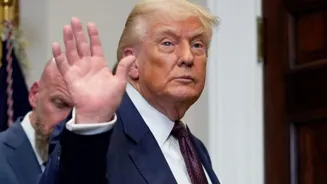This rally, driven by a combination of geopolitical anxieties, currency fluctuations and safe-haven demand, highlights the precious metal’s enduring role as a refuge during periods of global instability.
Trump's tariff barrage
At the heart of this rally lies US President Donald Trump's aggressive return to protectionist trade policies. The reintroduction of steep tariffs—most notably a 50 per cent levy on Indian imports and a 39 per cent duty on Swiss goods—has thrown global trade routes into disarray. These
Experts believe that these tariffs will not only dent India's economic growth, possibly shaving off between 0.3 per cent and 0.6 per cent of its GDP, but also exert downward pressure on the Indian rupee. This currency depreciation has made gold more expensive in rupee terms, further pushing up
Dollar falters, gold shines brighter
While tariff anxiety is undoubtedly a major contributor to the rally, weakness in the US dollar has also played a crucial supporting role. As the greenback slipped nearly 0.5 per cent to 97.96 during recent trading sessions, gold became cheaper in other currencies, making it more attractive to global investors. This phenomenon, often seen during periods of declining confidence in fiat currencies, has historically coincided with rising bullion prices.
Commodity analysts believe this depreciation reflects broader investor uncertainty over the US economic outlook, with sluggish job growth and slowing services activity creating concerns about the Federal Reserve’s next move.
A blow to Swiss gold exports
Further compounding the gold price surge was a surprising move by the US Customs and Border Protection agency, which ruled that one-kilo and 100-ounce gold bars—commonly traded on Comex—would now be subject to import duties. This decision disrupted expectations that such bars,
A Financial Times report said Switzerland exported over $61 billion worth of gold to the US in the year leading up to June 2025. The newly imposed 39 per cent tariff on these imports could translate to an additional $24 billion in levies, placing enormous strain on Swiss refineries and creating ripple effects throughout the global bullion trade.
India’s gold demand plunges despite price rally
While investors have flocked to
Despite these high prices, demand for physical gold in India has plummeted. The World Gold Council’s (WGC) Q2 2025 report highlighted a 10 per cent year-on-year drop in Indian gold consumption during the April–June quarter, falling to 134.9 tonnes from 149.7 tonnes in the same period last year.
Investment demand
Institutional buying has emerged as another pillar supporting the rally. As reported by The Economic Times, central banks have continued to add to their reserves, while exchange-traded fund (ETF) inflows have surged in recent weeks.
This trend, coupled with growing fears of a global economic slowdown and the potential for the Federal Reserve to cut interest rates in September, has
China’s role and the Fed’s future path
Adding further intrigue to the mix is China’s quiet accumulation of gold. According to analysts cited by the Times of India, sustained buying by the Chinese central bank has helped some sort of stabilisation amid international uncertainty.
Meanwhile, expectations that Trump will soon announce a new more dovish Federal Reserve Chair have injected fresh speculation into the rate policy debate.
A shifting
scene for gold
As the global financial system reels from trade wars, geopolitical volatility and policy realignments, gold has reasserted itself as a pillar of stability. While the rally has curtailed traditional demand in price-sensitive markets like India, it has simultaneously sparked increased interest from investors seeking a hedge against uncertainty.
Whether this rally marks a temporary spike or the beginning of a longer bull run will depend on how these macro and geopolitical factors evolve. But one thing is clear













